Geopolymerization Ability of Natural and Secondary Raw Materials by Solubility Test in Alkaline Media
Abstract
:1. Introduction
2. Experimental
- (1)
- by mixing 0.5 g of solid with 20 mL of alkaline solution (NaOH) for fixed times under continuous stirring. After filtering each sample, the liquid part is diluted to 250 mL, the pH is adjusted to pH < 1 by adding concentrated HCl acid and ICP is used in order to determine the Al and Si concentration. The variables studied are the concentration of the alkaline solution (3 and 7 M) and the time of dissolution (5, 10, 24 and 72 h). Mass solution/solid ratio: 40:1.
- (2)
- by putting into contact 0.5 g of solid with 500 mL of alkaline solution (NaOH) in static condition at 60 °C. At fixed times, 5 mL of solution have been collected and, after filtering, the pH has been adjusted to pH < 1 by adding concentrated HCl acid and ICP is used in order to determine the Al and Si concentration. The variables studied are: the concentration of the alkaline solution (3 and 7 M) and the time of dissolution (1, 3, 7 and 14 days). Mass solution/solid ratio: 1000:1.
3. Results and Discussion
3.1. Extent of Si (Al) Dissolution
3.2. Effect of Heat-Treatment on Leachability of NYT
- (a)
- chabazite (C) and phillipsite (P) structures collapse within about 600 °C;
- (b)
- crystallization of alkali feldspar (F), presumably a K-feldspar (K,Na)AlSi3O8, is observed at about 800 °C, with some residual analcime and an amorphous phase still present;
- (c)
- the sample appears nearly amorphous, apart a very limited presence of feldspars at 800 °C.
3.3. Characterization of the Solid Residue
4. Conclusions
Acknowledgments
Author Contributions
Conflicts of Interest
References
- Davidovits, J. Geopolymers: Inorganic polymeric new materials. J. Therm. Anal. Calorim. 1991, 37, 1633–1656. [Google Scholar] [CrossRef]
- Duxson, P.; Fernández-Jiménez, A.; Provis, J.L.; Lukey, G.C.; Palomo, A.; Van Deventer, J.S.J. Geopolymer technology: The current state of the art. J. Mater. Sci. 2007, 42, 2917–2933. [Google Scholar] [CrossRef]
- Van Deventer, J.S.; Provis, J.L.; Duxson, P.; Brice, D.G. Chemical research and climate change as drivers in the commercial adoption of alkali activated materials. Waste Biomass Valoriz. 2010, 1, 145–155. [Google Scholar] [CrossRef]
- Xu, H.; Van Deventer, J.S.J. The geopolymerisation of alumino-silicate minerals. Int. J. Miner. Process. 2000, 59, 247–266. [Google Scholar] [CrossRef]
- Xu, H.; Van Deventer, J.S.J. The effect of alkali metals on the formation of geopolymeric gels from alkali-feldspars. Colloids Surf. A Physicochem. Eng. Asp. 2003, 216, 27–44. [Google Scholar] [CrossRef]
- Xu, H.; Van Deventer, J.S.J.; Lukey, G.C. Effect of alkali metals on the preferential geopolymerization of stilbite/kaolinite mixtures. Ind. Eng. Chem. Res. 2001, 40, 3749–3756. [Google Scholar] [CrossRef]
- Peirce, S.; Santoro, L.; Andini, S.; Montagnaro, F.; Ferone, C.; Cioffi, R. Clay Sediment Geopolymerization by Means of Alkali Metal Aluminate Activation. RSC Adv. 2015, 5, 107662–107669. [Google Scholar] [CrossRef]
- Messina, F.; Ferone, C.; Molino, A.; Roviello, G.; Colangelo, F.; Molino, B.; Cioffi, R. Synergistic recycling of calcined clayey sediments and water potabilization sludge as geopolymer precursors: Upscaling from binders to precast paving cement-free bricks. Constr. Build. Mater. 2017, 133, 14–26. [Google Scholar] [CrossRef]
- Fernández-Jiménez, A.; Palomo, A.; Criado, M. Microstructure development of alkali-activated fly ash cement: A descriptive model. Cem. Concr. Res. 2005, 35, 1204–1209. [Google Scholar] [CrossRef]
- Messina, F.; Ferone, C.; Colangelo, F.; Cioffi, R. Low temperature alkaline activation of weathered fly ash: Influence of mineral admixtures on early age performance. Constr. Build. Mater. 2015, 86, 169–177. [Google Scholar] [CrossRef]
- Ferone, C.; Colangelo, F.; Messina, F.; Iucolano, F.; Liguori, B.; Cioffi, R. Coal combustion wastes reuse in low energy artificial aggregates manufacturing. Materials 2013, 6, 5000–5015. [Google Scholar] [CrossRef] [Green Version]
- Ferone, C.; Colangelo, F.; Messina, F.; Santoro, L.; Cioffi, R. Recycling of Pre-Washed Municipal Solid Waste Incinerator Fly Ash in the Manufacturing of Low Temperature Setting Geopolymer Materials. Materials 2013, 6, 3420–3437. [Google Scholar] [CrossRef]
- Fletcher, R.A.; MacKenzie, K.J.; Nicholson, C.L.; Shimada, S. The composition range of aluminosilicate geopolymers. J. Eur. Ceram. Soc. 2005, 25, 1471–1477. [Google Scholar] [CrossRef]
- Cristelo, N.; Tavares, P.; Lucas, E.; Miranda, T.; Oliveira, D. Quantitative and qualitative assessment of the amorphous phase of a Class F fly ash dissolved during alkali activation reactions—Effect of mechanical activation, solution concentration and temperature. Compos. B Eng. 2016, 103, 1–14. [Google Scholar] [CrossRef]
- Fernández-Jiménez, A.; De La Torre, A.G.; Palomo, A.; López-Olmo, G.; Alonso, M.M.; Aranda, M.A.G. Quantitative determination of phases in the alkali activation of fly ash. Part I. Potential ash reactivity. Fuel 2006, 85, 625–634. [Google Scholar] [CrossRef]
- Panagiotopoulou, C.; Kontori, E.; Perraki, T.; Kakali, G. Dissolution of aluminosilicate minerals and by-products in alkaline media. J. Mater. Sci. 2007, 42, 2967–2973. [Google Scholar] [CrossRef]
- Buchwald, A.; Hohmann, M.; Posern, K.; Brendler, E. The suitability of thermally activated illite/smectite clay as raw material for geopolymer binders. Appl. Clay Sci. 2009, 46, 300–304. [Google Scholar] [CrossRef]
- Ferone, C.; Liguori, B.; Capasso, I.; Colangelo, F.; Cioffi, R.; Cappelletto, E.; Di Maggio, R. Thermally treated clay sediments as geopolymer source material. Appl. Clay Sci. 2015, 107, 195–204. [Google Scholar] [CrossRef]
- Lampris, C.; Lupo, R.; Cheeseman, C.R. Geopolymerisation of silt generated from construction and demolition waste washing plants. Waste Manag. 2009, 29, 368–373. [Google Scholar] [CrossRef] [PubMed]
- Villa, C.; Pecina, E.T.; Torres, R.; Gómez, L. Geopolymer synthesis using alkaline activation of natural zeolite. Constr. Build. Mater. 2010, 24, 2084–2090. [Google Scholar] [CrossRef]
- Heller-Kallai, L. Thermally Modified Clay Minerals. Dev. Clay Sci. 2006, 1, 289–308. [Google Scholar]
- Mendelovici, E. Comparative study of the effects of thermal and mechanical treatments on the structures of clay minerals. J. Therm. Anal. Calorim. 1997, 49, 1385–1397. [Google Scholar] [CrossRef]
- He, C.; Osbæck, B.; Makovicky, E. Thermal stability and pozzolanic activity of raw and calcined mixed-layer mica/smectite. Appl. Clay Sci. 2000, 17, 141–161. [Google Scholar] [CrossRef]
- Kakali, G.; Perraki, T.; Tsivilis, S.; Badogiannis, E. Thermal treatment of kaolin: The effect of mineralogy on the pozzolanic activity. Appl. Clay Sci. 2001, 20, 73–80. [Google Scholar] [CrossRef]
- Liguori, B.; Cassese, A.; Colella, C. Safe immobilization of Cr (III) in heat-treated zeolite tuff compacts. J. Hazard. Mater. 2006, 137, 1206–1210. [Google Scholar] [CrossRef] [PubMed]
- Liguori, B.; Caputo, D.; Iucolano, F.; Aprea, P.; De Gennaro, B. Entrapping of Cs and Sr in heat-treated zeolite matrices. J. Nucl. Mater. 2013, 435, 196–201. [Google Scholar] [CrossRef]
- Miller, F.A.; Wilkins, C.H. Infrared spectra and characteristic frequencies of inorganic ions. Anal. Chem. 1952, 24, 1253–1294. [Google Scholar] [CrossRef]
- Granizo, M.L.; Santiago, A.; Blanco-Varela, M.T.; Palomo, A. Alkaline Activation of Metakaolin: Effect of Calcium Hydroxide in the Products of Reaction. J. Am. Ceram. Soc. 2002, 85, 225–231. [Google Scholar] [CrossRef]
- Pingitore, N.E., Jr.; Fretzdorff, S.B.; Seitz, B.P.; Estrada, L.Y.; Borrego, P.M.; Crawford, G.M.; Love, K.M. Dissolution kinetics of CaCO3 in common laboratory solvents. J. Sediment. Res. 1993, 63, 641–645. [Google Scholar]

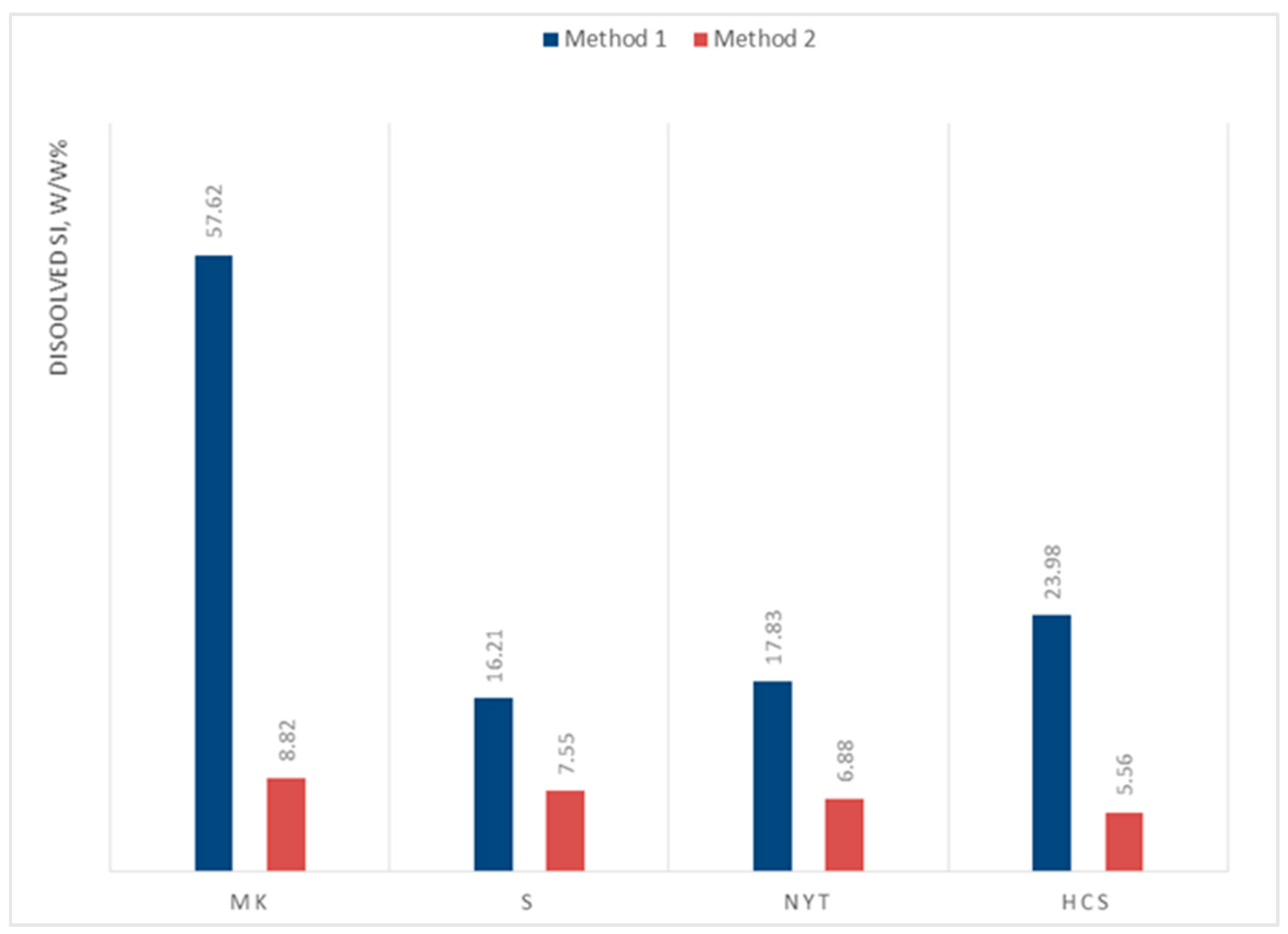
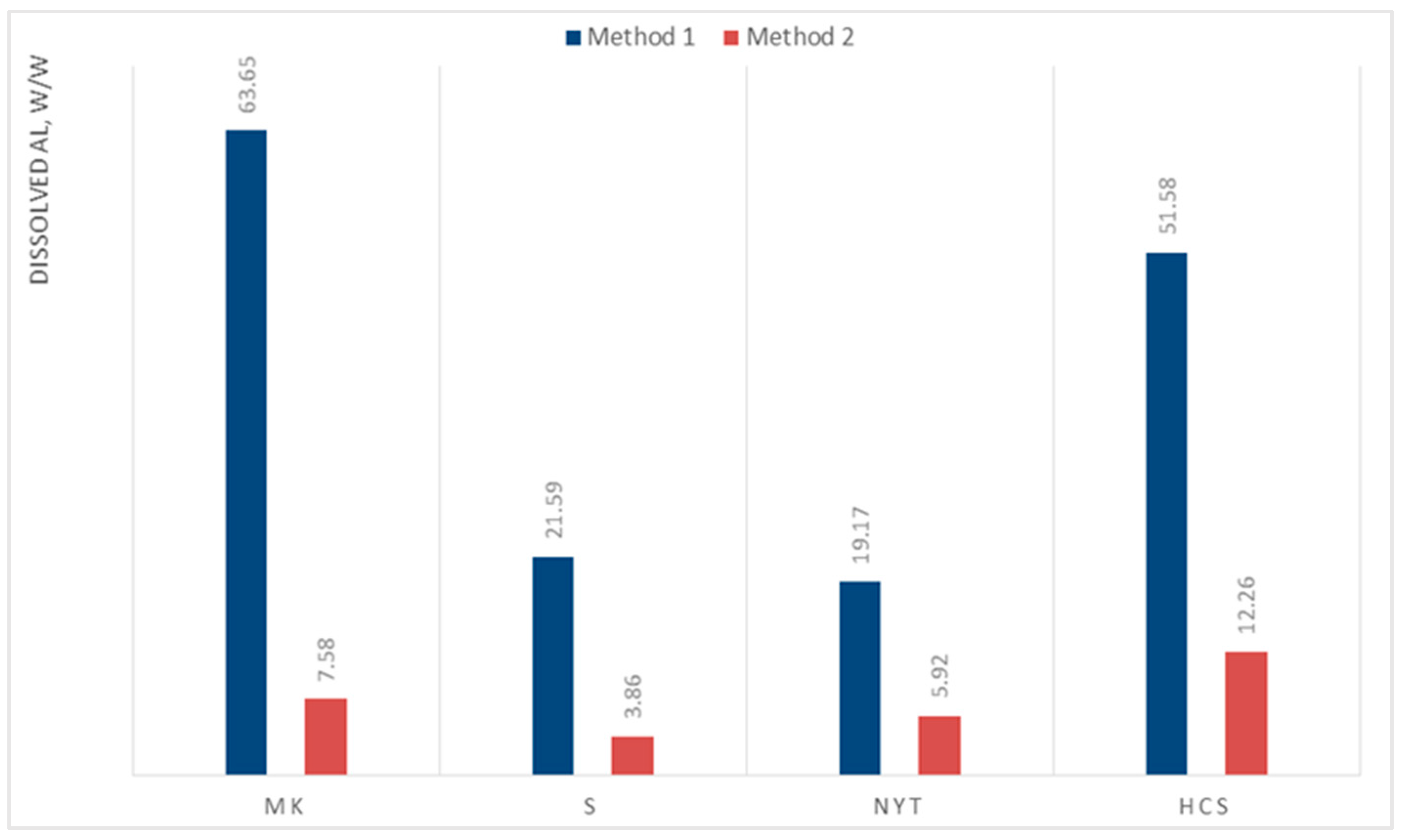

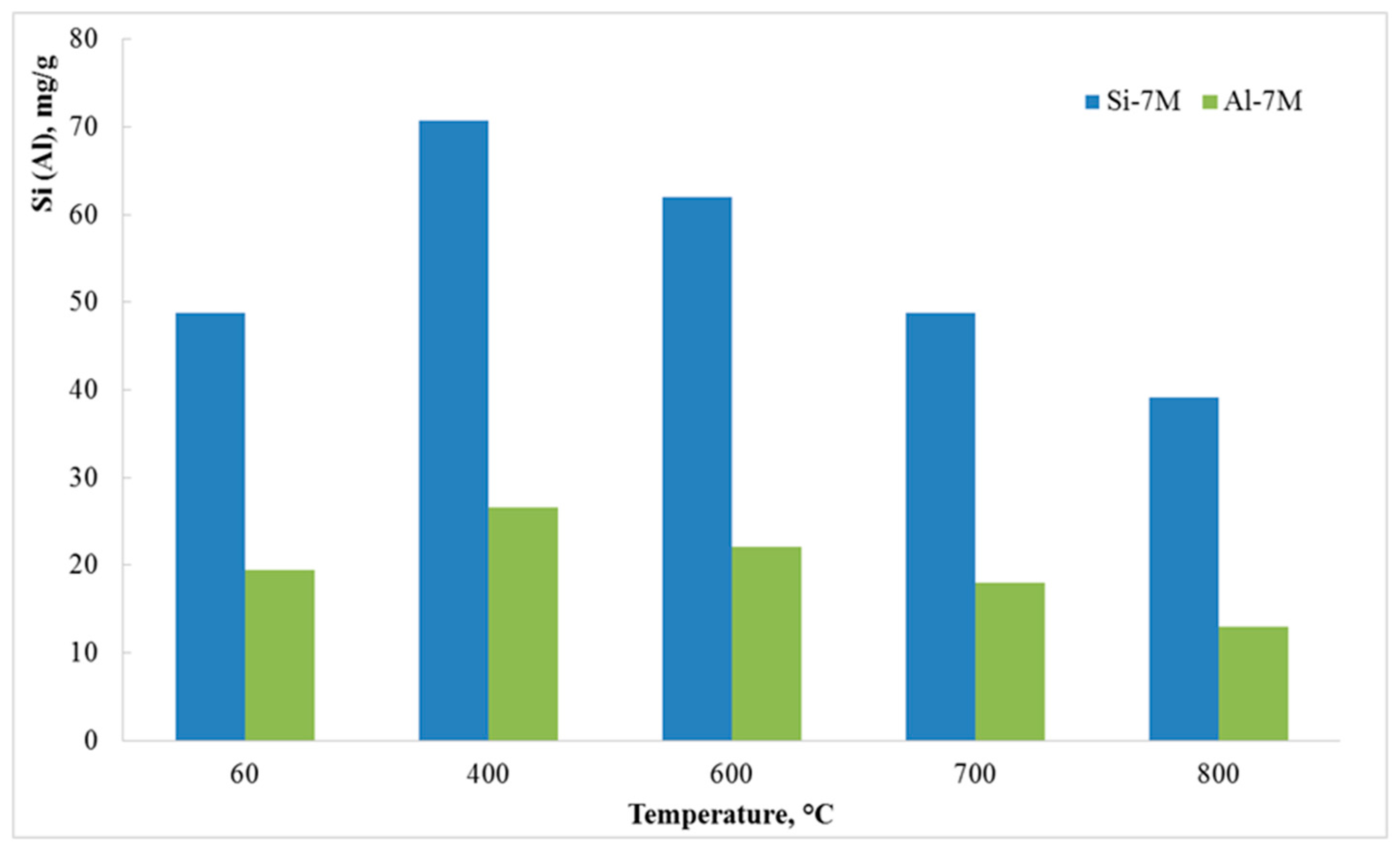
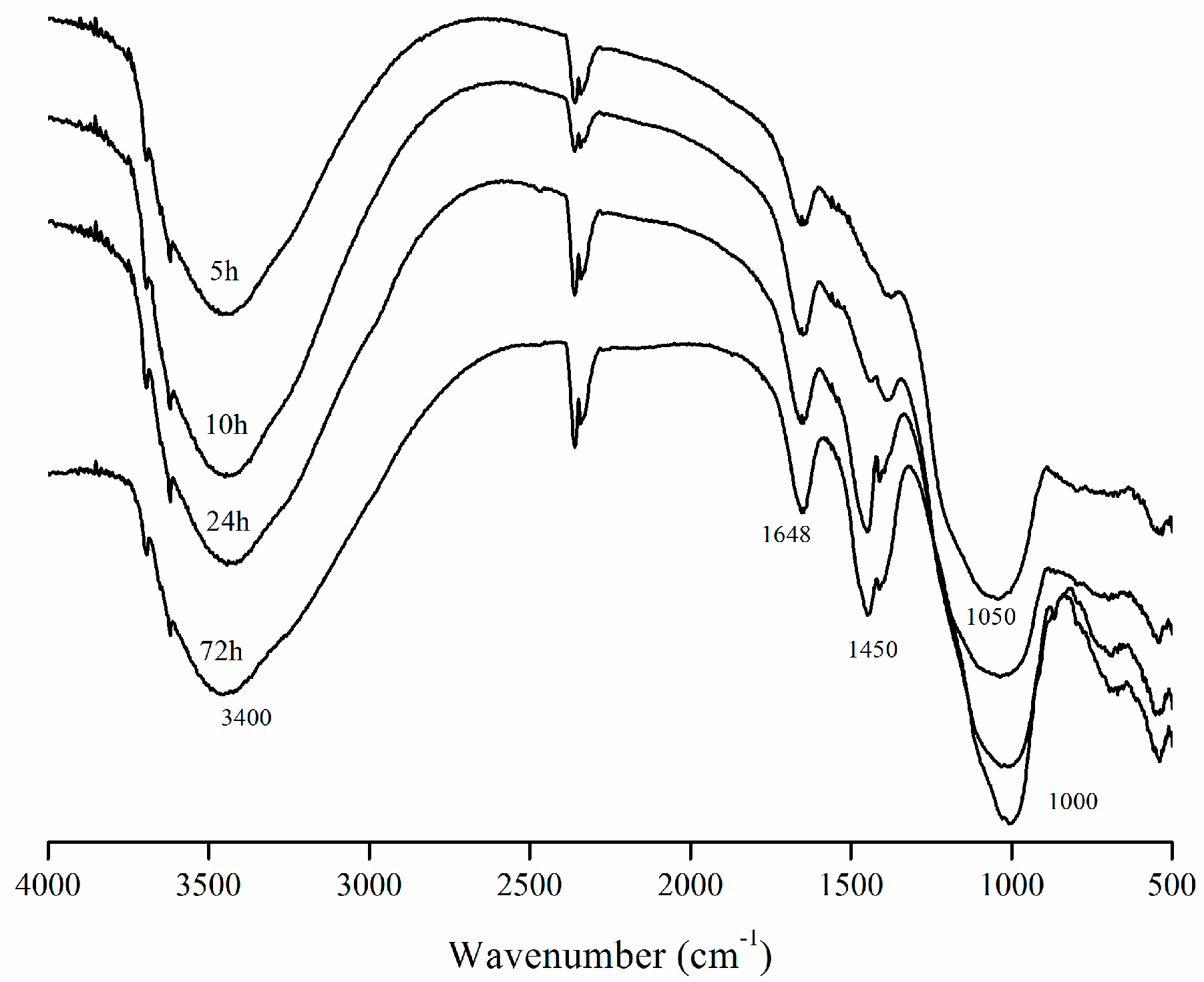
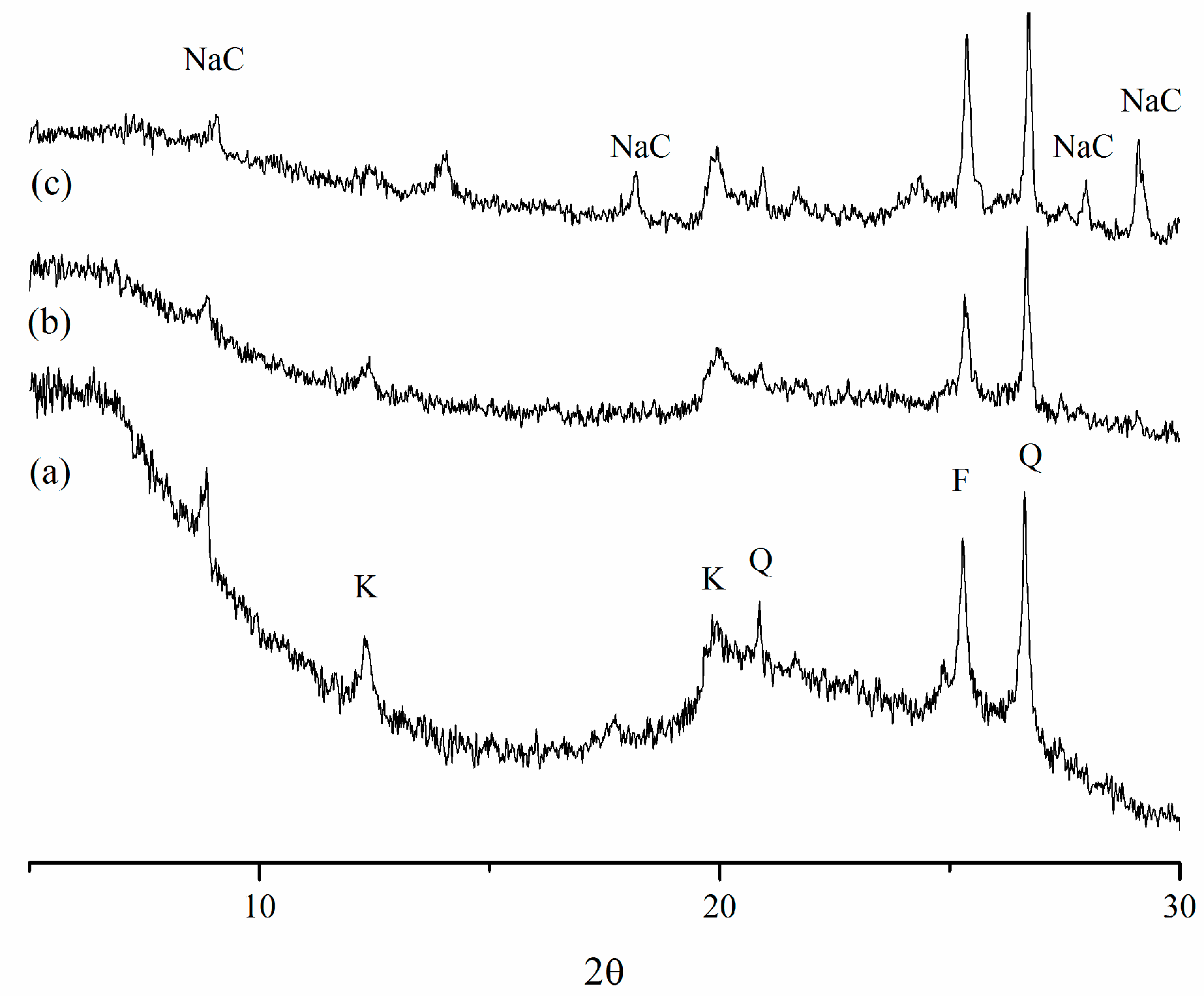
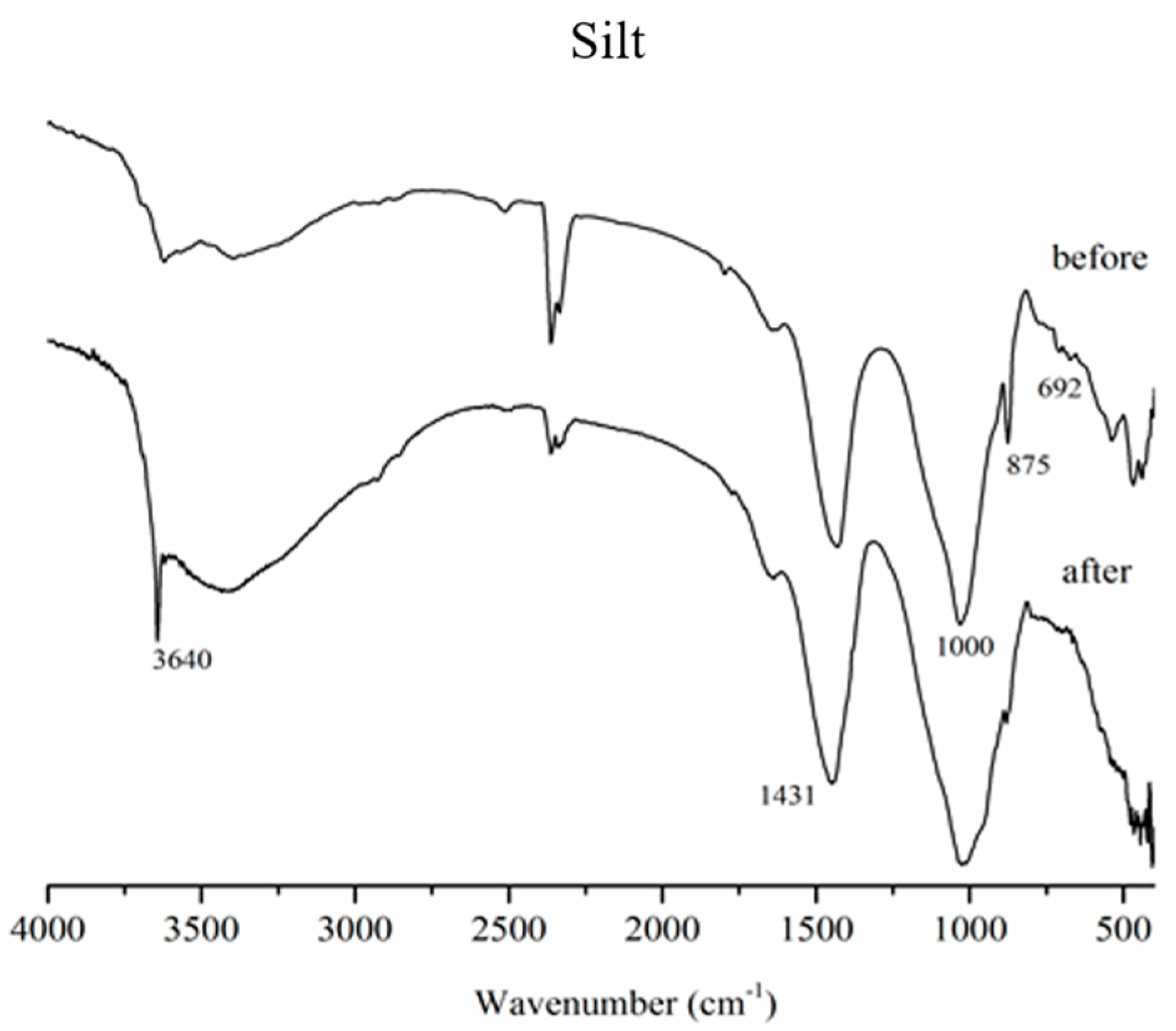
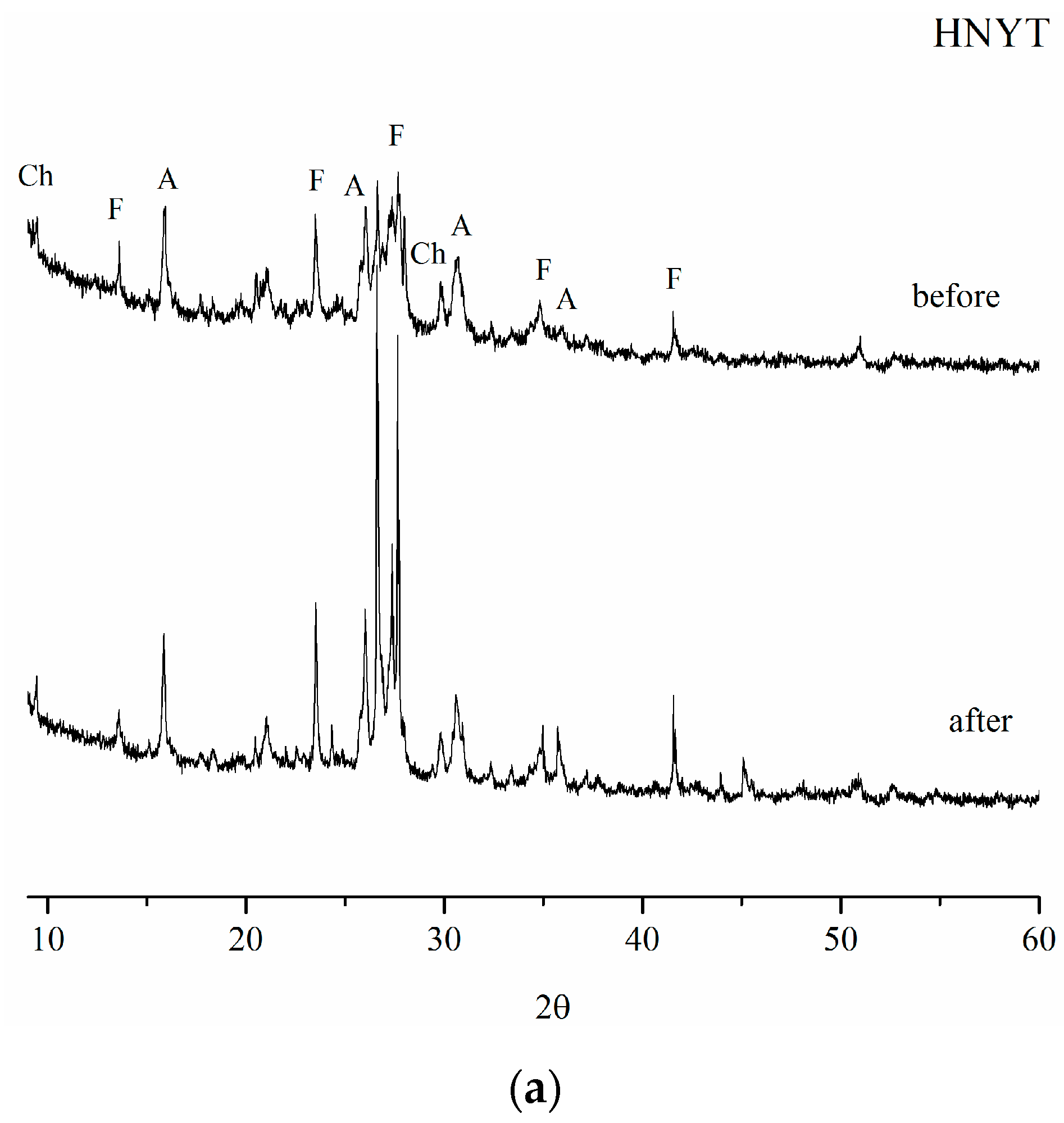
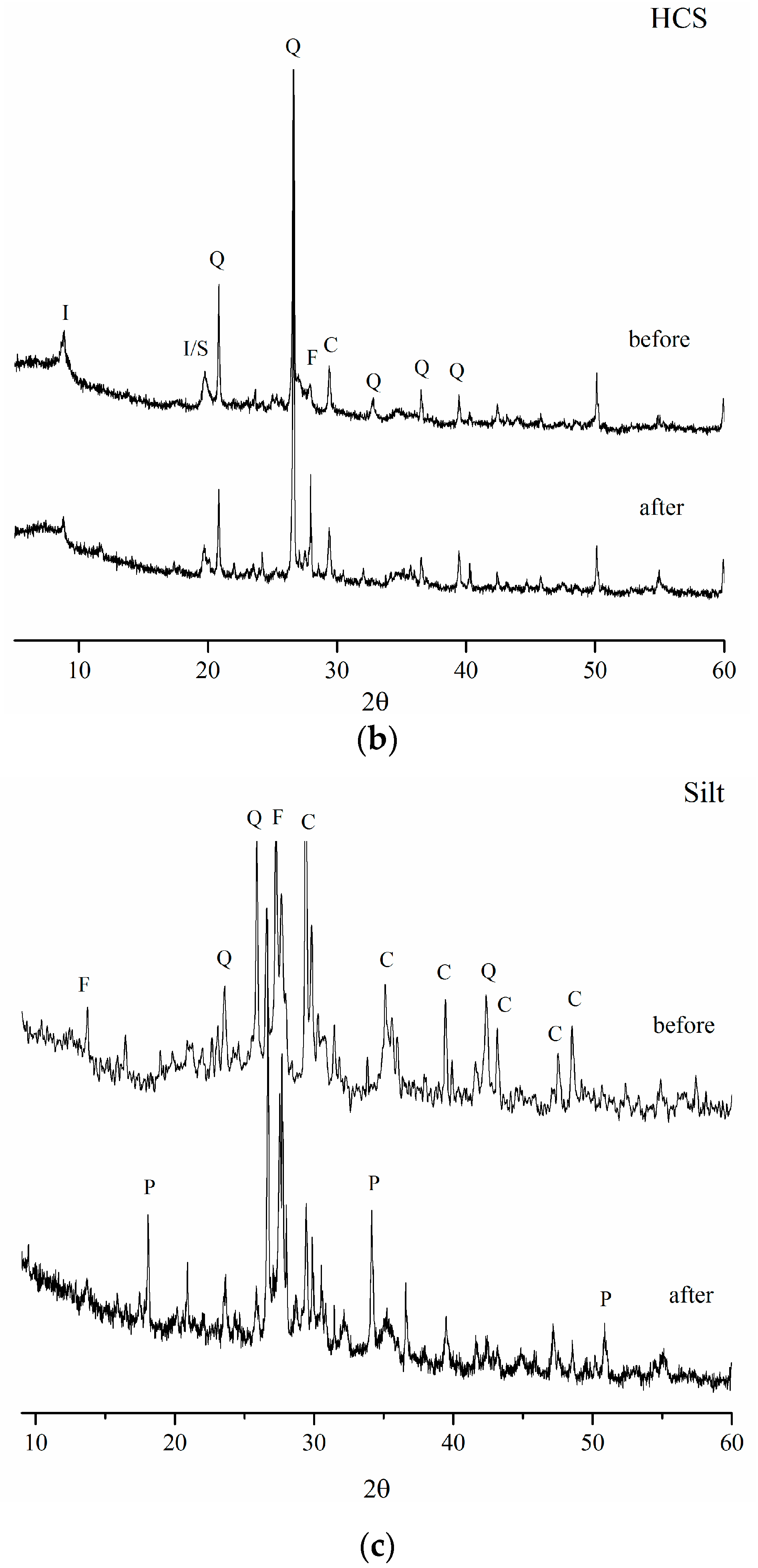
| Oxide | MK | S | NYT | HCS |
|---|---|---|---|---|
| SiO2 | 52.90 | 33.38 | 58.52 | 52.54 |
| Al2O3 | 41.90 | 12.35 | 19.10 | 16.75 |
| Fe2O3 | 1.60 | 3.88 | 4.60 | 5.97 |
| CaO | 0.17 | 17.53 | 3.01 | 7.29 |
| MgO | 0.19 | 1.64 | 1.11 | 2.03 |
| K2O | 0.77 | 3.52 | 9.39 | 1.79 |
| Na2O | - | 0.99 | 3.44 | 0.99 |
| SO3 | - | - | - | - |
| TiO2 | 1.80 | - | - | - |
| Si/Al | 1.12 | 2.39 | 2.71 | 2.77 |
| Sample | Mineral Phases |
|---|---|
| MK | Quartz , kaolinite |
| S | Quartz, calcite |
| NYT | Phillipsite, chabazite, analcime, feldspars |
| CS | Quartz, kaolinite, illite, calcite |
| Extent Al (mg/g) | Extent Si (mg/g) | ||||||||
|---|---|---|---|---|---|---|---|---|---|
| MK | S | NYT | HCS | MK | S | NYT | HCS | ||
| 3M | Hours | ||||||||
| 5 | 56.10 | 4.30 | 1.59 | 14.89 | 56.80 | 7.66 | 5.70 | 27.93 | |
| 10 | 72.90 | 5.46 | 2.80 | 15.10 | 74.10 | 7.96 | 9.16 | 25.93 | |
| 24 | 77.45 | 7.51 | 7.61 | 14.69 | 76.95 | 7.31 | 20.66 | 21.27 | |
| 72 | 76.50 | 9.03 | 13.28 | 34.88 | 74.60 | 6.92 | 34.06 | 43.30 | |
| 7M | |||||||||
| 5 | 61.90 | 8.22 | 2.87 | 16.95 | 64.65 | 13.99 | 9.25 | 29.59 | |
| 10 | 87.65 | 9.67 | 5.53 | 10.59 | 87.25 | 17.05 | 15.10 | 17.01 | |
| 24 | 119.90 | 11.22 | 12.48 | 20.53 | 118.75 | 19.27 | 33.27 | 34.88 | |
| 72 | 141.15 | 14.11 | 19.38 | 33.72 | 142.50 | 25.30 | 48.78 | 60.20 | |
| Extent Al (mg/g) | Extent Si (mg/g) | ||||||||
|---|---|---|---|---|---|---|---|---|---|
| MK | S | NYT | HCS | MK | S | NYT | HCS | ||
| 3M | Days | ||||||||
| 1 | 193.40 | 21.03 | 37.14 | 47.92 | 243.50 | 87.05 | 142.50 | 94.67 | |
| 3 | 197.70 | 26.77 | 47.07 | 50.63 | 249.00 | 103.10 | 162.30 | 129.3 | |
| 7 | 207.40 | 28.93 | 63.97 | 53.29 | 276.10 | 106.30 | 208.00 | 137.3 | |
| 14 | 144.50 | 11.76 | 80.04 | 50.91 | 215.90 | 67.88 | 256.80 | 144 | |
| 7M | |||||||||
| 1 | 172.60 | 20.71 | 45.85 | 39.91 | 226.30 | 101.60 | 177.90 | 91.56 | |
| 3 | 168.00 | 25.24 | 59.84 | 54.32 | 218.10 | 117.90 | 188.30 | 136.7 | |
| 7 | 169.00 | 31.35 | 58.47 | 54.92 | 218.00 | 129.20 | 213.20 | 140.8 | |
| 14 | 145.40 | 33.91 | 60.45 | 50.87 | 212.20 | 134.80 | 173.00 | 130 | |
© 2017 by the authors. Licensee MDPI, Basel, Switzerland. This article is an open access article distributed under the terms and conditions of the Creative Commons Attribution (CC BY) license (http://creativecommons.org/licenses/by/4.0/).
Share and Cite
Liguori, B.; Capasso, I.; De Pertis, M.; Ferone, C.; Cioffi, R. Geopolymerization Ability of Natural and Secondary Raw Materials by Solubility Test in Alkaline Media. Environments 2017, 4, 56. https://doi.org/10.3390/environments4030056
Liguori B, Capasso I, De Pertis M, Ferone C, Cioffi R. Geopolymerization Ability of Natural and Secondary Raw Materials by Solubility Test in Alkaline Media. Environments. 2017; 4(3):56. https://doi.org/10.3390/environments4030056
Chicago/Turabian StyleLiguori, Barbara, Ilaria Capasso, Marco De Pertis, Claudio Ferone, and Raffaele Cioffi. 2017. "Geopolymerization Ability of Natural and Secondary Raw Materials by Solubility Test in Alkaline Media" Environments 4, no. 3: 56. https://doi.org/10.3390/environments4030056






